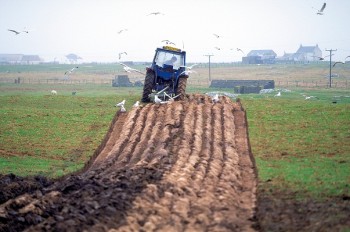Supporting guidance for Cropped Machair
Date published: 2 November, 2017
For recent changes to this guidance, please see the bottom of the page.
Machair is one of the rarest habitats in Europe, found only in the north and west of Britain and Ireland.
Most of the Scottish machair occurs in the Hebrides, with the best and most extensive areas in the Uists, Barra and Tiree.
Machair land has unique sandy soils with a high shell content.

Credit: Ian White – © Scottish Natural Heritage
Traditional cropping on these soils offers a valuable habitat for a variety of wildlife, particularly birds and insects.
The combination of traditional cropping and fallow rotation benefits the annual flowers which rely on the production of a seedbed.
The absence of under-sown grass or reseeding allows all of the flowers in the soil’s seed bank to develop during the fallow period without competition.
The wide variety of plants flowering within the crop during the fallow periods provides pollen and nectar for species such as the rare great yellow bumblebee.
The weed seeds and grain support the corn bunting and many other seed-eating birds.

Cropped machair – Credit: Jamie Boyle
How to increase the success of this option
There are cereal varieties indigenous to machair cropping. These are ideally suited to the sandy machair soils and can be grown with low agricultural inputs.
These indigenous cereals are culturally valuable and they hold a genetic diversity that may be useful for future crop breeding.
Keep some of the crop to be threshed for next year’s seed to maintain this valuable resource and support the small remaining network of threshing mills.
Use of seaweed and shallow ploughing (ploughing to a depth of less than 15 centimetres – or six inches) to help maintain organic matter levels and soil structure.
Farmyard manure and slow-release phosphates can also boost yields on the light sandy soil but high nitrogen inorganic fertilisers are unlikely to be beneficial or cost effective.
They may promote more aggressive species and reduce the variety of plants growing in the crop.
Cut the crop as late as possible after the 1 September to provide cover for corncrakes and to allow the later-flowering plants to set seed. Where corncrakes are present the crop must be cut in a wildlife-friendly manner.
Cutting derogation
A derogation may be applied for, to cut earlier (from 16 to 31 August), if the crop is suffering significant goose damage. However, to prevent damage to any nesting corncrake, you must cut in a corncrake-friendly manner (see supporting guidance for Corncrake Mown Grassland option).
To apply for a derogation the following information must be supplied to your case officer:
- photographs showing goose damage
- written confirmation that you are not receiving payment through a goose management scheme
Your request may be considered in consultation with local RSPB staff.
If agreed, written confirmation will be provided, which must be shown at inspection. You must record the revised cutting date and make clear reference to the derogation in your management diary.

Further information
Where machair land has not been cropped for a long time Environmental Impact Assessment (EIA) regulations may apply.
Contact your local Scottish Natural Heritage or Rural Payments and Inspections Division office for more information.
